Sales Strategy
Psychological Pricing Techniques to Improve Sales and Profit Margins January 30, 2024 (0 comments)

Istanbul, Türkiye--Research states that 87% of online shoppers rank price as a crucial determinant in their buying decisions. Thus, striking the right balance in pricing is pivotal: Overpricing may alienate potential customers, while underpricing can erode your profits. The art lies in compellingly pricing products so customers feel they're making a smart purchase.
[Photo by engin akyurt on Unsplash]
Pricing is not just about numbers; it's also about psychology, and an article published in Prisync suggests just that.
Understanding Psychological Pricing
Psychological pricing is not a mere tactic; it's a nuanced approach that taps into the cognitive processes of consumers. It's been a staple in traditional retail and is now a significant game-changer in the digital marketplace. By addressing the subconscious decision-making level, psychological pricing strategies can significantly enhance sales volume and profit margins.
The article looks into the following pricing strategies.
Top Psychological Pricing Strategies for E-commerce Success
The Magic of Number '9': The number '9' might seem ordinary, but it holds exceptional pricing sway. Tagging a price as $0.99 rather than rounding it up can make a substantial difference. The 'left-digit effect' suggests consumers focus on the first digit, making $399.99 feel substantially closer to $300 than $400. This phenomenon, used by major e-commerce platforms, can make prices seem more appealing, driving up sales.
Strategic Price Visualization: The brain's perception of numbers and sizes can be leveraged in pricing display. Smaller font sizes can make prices seem smaller because visual and numerical magnitudes are processed similarly. Additionally, eliminating commas from prices, like $1299 instead of $1,299, reduces the phonetic length and, consequently, the perceived magnitude of the price.
Perceived Quality Through Higher Pricing: Higher prices often translate to perceived superior quality. Prestige pricing, or high prices, can align your product with notions of luxury and quality. This strategy is particularly potent in markets where consumers equate price with value, making it essential not to undermine your product's perceived quality by pricing it too low.
Maximizing the Comparison Pricing Strategy: Shoppers instinctively compare prices before purchasing. Businesses can effectively highlight the superior product's value by strategically positioning a high-value product alongside a more modestly priced counterpart, encouraging consumers to opt for the higher-price option.
The Advantages of Bundle Pricing: Offering products in a bundle can significantly boost sales. This strategy plays on the customer's perception of getting more value for money, simplifying the decision-making process and often increasing the perceived value of the primary product.
Learn more in the article on Prisync.






